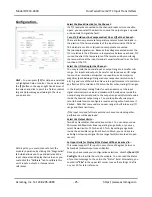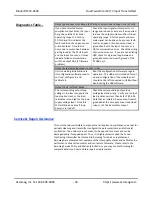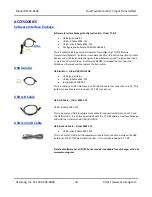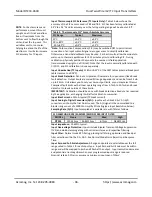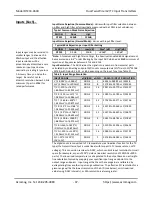
Model DT233-0600
Dual Two-Wire mV/TC Input Transmitters
Acromag, Inc. Tel: 248-295-0880
- 35 -
http://www.acromag.com
- 35 -
https://www.acromag.com
SPECIFICATIONS
Model Numbers
Model DT233-0600
Dual isolated mV/TC Inputs
(J, K, T, E, R, S, B, N, or ±100mV),
Two-Wire Loop-Powered Outputs
CE Approved
Includes cULus Class I, Div 2,
ATEX/IECEx approvals
Custom calibration to your
specifications can be added as a
separate line item at time of
purchase.
The DT model prefix denotes Dual Transmitter. The 3
rd
digit “2” denotes a member
of the Acromag DT200 2-wire loop-powered Transmitter family. The trailing 33
denotes a thermocouple/millivoltage input type.
The “
-
0600” model
suffix specifies a
loop-powered unit with CE and cULus Class I, Division 2, ATEX/IECEx Zone 2
Approvals.
Models can be mounted on standard 35mm “T” Type DIN rail.
Optional factory calibration to your own specifications is ordered as a separate line
item at time of purchase, on a per unit basis. This requires the specification of each
input type (J, K, T, E, R, S, B, N, or ±100mV), their input range zero values (mV or °C),
their input range full-scale values, and the channel fault detent (upscale or
downscale). You can also specify a normal 4-20mA or reverse 20-4mA acting output,
a channel filter level (none, low, medium, or high), and whether channel CJC is ON or
OFF.
Standard models without adding factory calibration are calibrated by default to
reference test conditions for T/C Type set to J, a 0°C to 200°C input range at both
channels, inputs mapped to normal acting 4.000mA to 20.000mA outputs, upscale
fault detection, and channel CJC turned ON. Field recalibration of any model will
require use of the TTC-SIP configuration kit, ordered separately (see Accessories).
Inputs (Each)
This unit has separate isolated
input channels for thermocouple
or DC millivoltage signals at TB1
(channel 1) and TB3 (channel 2).
Input Reference Test Conditions:
TC Type J with a 10mV minimum span (e.g. Type J,
0 to 200
C), or ±100mV range with a 10mV minimum calibrated span; Output 4-
20mA
into 250Ω
; Ambient = 25
C; Power Supply = 24VDC.
Input Range & Accuracy:
Unit has two separate input channels at TB1 & TB3 for the
ranges indicated (unit provides TC linearization, Cold-Junction Compensation (CJC), &
lead break detection).
Table 1: Ranges/Accuracy
ISA/ANSI
Typical
1
T/C
T/C Material
Color
C Temp Range
Accuracy
J
+Iron, -Constantan
White/Red
-210 to +760
C
0.5
C
K
+Chromel, -Alumel
Yellow/Black -200 to +1372
C
0.5
C
T
+Copper, -Constantan
Blue/Red
-260 to +400
C
0.5
C
R
+Pt/13%Rh, -Constantan
Black/Red
- 50 to +1768
C
1.0
C
S
+Pt/10%Rh, -Constantan
Black/Red
- 50 to +1768
C
1.0
C
E
+Chromel, -Constantan
Purple/Red
-200 to +1000
C
0.5
C
B
+Pt/10%Rh, -Pt/6%Rh
Gray/Red
+260 to 1820
C
1.0
C
N
+Nicrosil, -NISIL
Orange/Red
-230 to -170
C;
-170 to +1300
C
1.0
C
0.5
C
mV
NA
NA
±100mV
±0.05%
±0.1% Max
1
Note (Table 1):
Accuracy is generally ±0.1% of the full-scale span, typical, or per the
table 1 specification, whichever is greater. Accuracy in Table 1 is given with CJC
switched OFF. CJC uncertainty should be combined with the uncertainty numbers of
Table 1 to determine a potential overall inaccuracy. Relative inaccuracy with CJC
enabled may increase by as much as
0.5
C during the post power-on warm-up
period and will converge to
0.2
C typical after reaching thermal equilibrium in
about five minutes
.
Inputs (Each)
…





